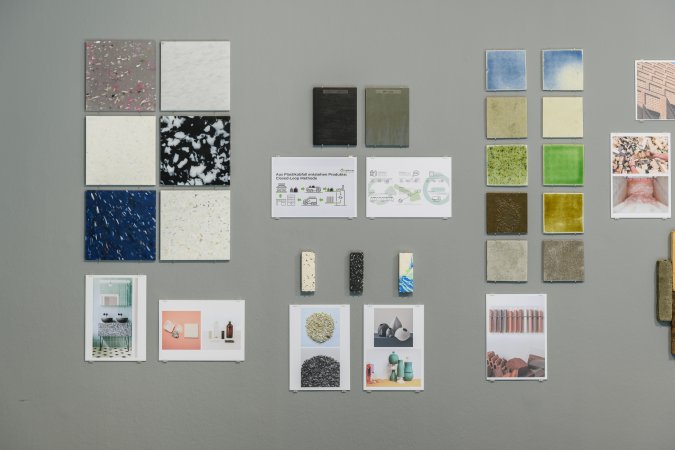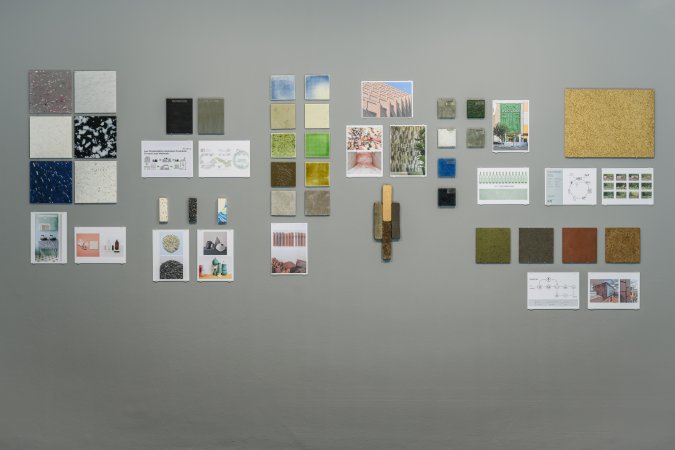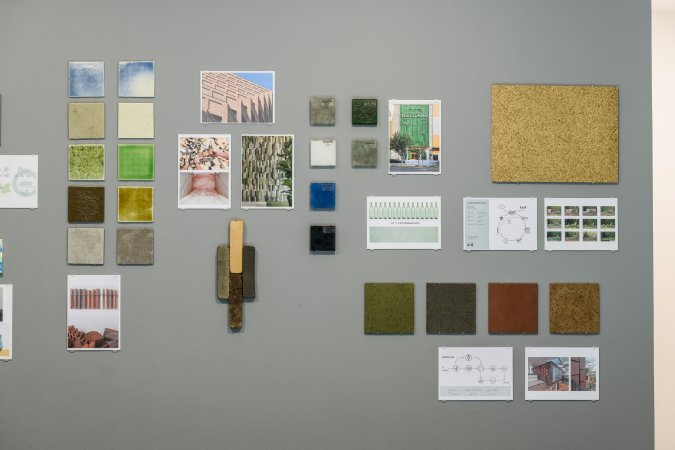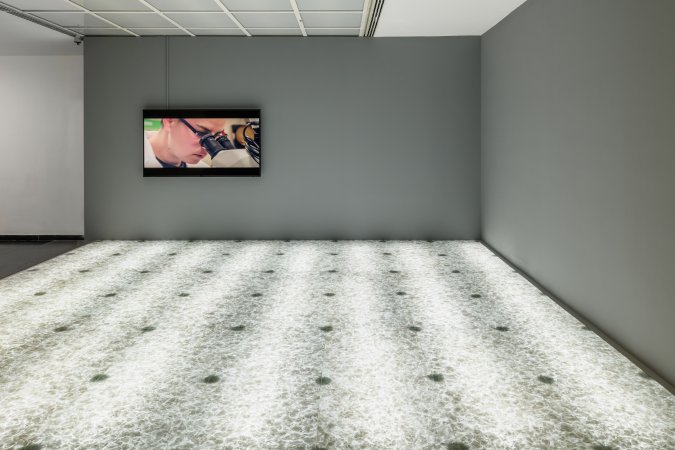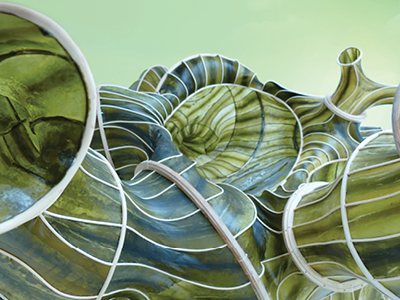New Materials
Magna Glaskeramik
Stormy Grey Bodenplatten, 2017
24 Glass panels from recycled crushed glass and surplus coated solar panels
Each 135 x 60 x 2 cm
Samples
6 Glass tiles made from recycled broken glass and surplus coated solar panels
Courtesy Magna Glaskeramik
BlueBlocks: Seawood
Samples
Fibreboards made from brown seaweed
Courtesy BlueBlocks
RikMakes: Compostboard
Samples
Boards made from agricultural waste
Courtesy RikMakes
Shards – Fliesen aus Bauschutt
Samples
Tiles from debris
Courtesy Shards – Fliesen aus Bauschutt
Smile Plastics
Samples
Panels made from recycled plastic waste
Courtesy Smile Plastics
Spared
Samples
Recycled shell from the fishing industry
StoneCycling
Samples
Bricks from construction waste
Courtesy StoneCycling
UpBoards
Samples
Surface panels made from recycled plastic waste
The 21st century is on the brink of a radical paradigm shift in how much material is produced and used under what conditions. The linear concept of “produce, use, dispose of” has proven unsustainable for humans to live on this planet in light of scarce resources, exponentially growing waste, and a rapidly increasing global population. To minimize the extraction of natural resources, cycles of production, use, and reuse must be developed. These will not only reduce resource consumption but enable a transformation of economic practices, too.
Knowing, Acting, Caring as the mindset of changed action has produced different stages of production and a range of materials that are no longer just subjects of speculative research, but are available for real-world applications. The young companies selected here represent a new generation of firms that have developed their economic models in the spirit of transformation. Magna Glaskeramik, Blue Blocks Seawood, Compost Board, Shards Tiles from debris, Smile Plastics, Spared, Stone Cycling, UpBoards, and Mogu all symbolize innovative business practices in the areas of New Materials. Recycling, Urban Mining, and the use of naturally renewable and biodegradable raw materials form the core of their product ranges.
The first stage of changed resource consumption involves the approach of recycling current materials. The aim here is to recycle existing, often oil-based materials rather than wasting them. This not only reduces energy consumption through new production but also reduces the amount of waste ending up in landfills worldwide. Recycling thus contributes to conserving our limited natural resources and minimizing environmental pollution. The prerequisite for recycling is the separation of individual materials. As many products are designed as composites of numerous individual components, separation is often difficult, leading valuable materials to end up in landfills. Altered design, new production methods, and more efficient separation of individual materials are thus the new challenges.
Cities and the built environment are constantly changing. What remains are tons of debris from concrete, bricks and various other building materials. The remnants are disposed of as construction waste in landfills. The awareness is growing, however, that demolition can serve as a source of recyclable materials. Urban Mining is a new economy and process that extracts raw materials not from nature but from previously created demolition. In this way, valuable resources from urban waste and old products can be recovered. Techniques such as recycling, reuse, and processing are used to recover metals, plastics, electronics and other resources from households, commercial areas and industrial waste. Urban Mining helps reduce dependence on primary sources of raw materials and promotes a more sustainable use of resources in urban environments.
Shards is a young company based in Kassel that specializes in the sustainable utilization of waste from the construction industry by manufacturing tiles from construction debris. The tiles completely avoid the use of primary raw materials, giving a second life to mineral waste materials that would normally end up in landfills and simultaneously establishing a circular system. In case of damage, they can be recycled into new tiles without turning into waste. The palette of colors and surface textures is produced without the need for dyes and ranges from white, cream, brown, gray, and black to green and blue tones. They can be glossy, textured, or rough. In the production of Shards tiles, the company relies on renewable energy sources, completely eliminating the use of fossil fuels. Due to their sustainability, the company was awarded the Federal Eco-Design Prize in 2018 and the German Sustainability Design Award in 2021.
StoneCycling is a Dutch company based in Amsterdam that likewise aims to reduce the construction industry’s use of primary raw materials. While still a student, industrial designer Tom van Soest designed a mixer that pulverizes demolition waste such as window glass, bricks and concrete. He later transformed this process on a large scale with the founding of StoneCycling. The resulting powder is mixed and fired, with recycled glass serving as a binder. The material that comes out of the oven has stone-like properties. StoneCycling today produces bricks or tiles for sustainable construction projects. In the Bending the Curve exhibition, their products from the WasteBasedBricks series are presented. The bricks are made from at least 60% up to 100% recycled materials, contributing to waste reduction by upgrading from 91 kg to 150 kg of waste per square meter. Production is carbon-neutral and adheres to industry standards. WasteBasedBricks are suitable for both interior and exterior applications and can be delivered in customized shapes and sizes.
The company Magna Glaskeramik, based in Teutschenthal, produces design products using glass waste. For the Bending the Curve exhibition, the company presents an installation with floor tiles in the color Stormy Grey. Magna Glaskeramik manufactures plates from 100% recycled custom glass, consisting of differently colored and fused shards. The color palette includes gray produced from coated solar panels, blue from blue mineral water bottles, green from beer bottles, black from flawed gray flat glass production, and white from waste glass deriving from solar cell protective glass. During the production of flat, solar, colored or bottle glass, rejects, production defects and surpluses of approximately 5% of the total glass production occur. These industrial waste materials serve as the raw material source for the production of Magna Glaskeramik: they are broken into shards in a controlled manner and then undergo an elaborate compaction process called sintering, without the addition of binders or the use of pressure, only by means of temperature and time. The sintered plates are then cooled in special hoods. In the final processing stage, the raw plates are calibrated, polished on request, and cut to the final size. The energy required in the production process is generated from their own solar panels, and the water used in the manufacturing process is recycled and reused multiple times.
The Smile Plastics, Spared, and UpBoards companies present material samples from their product ranges in Bending the Curve, all made from 100% recycled plastic granules. Plastic waste can be molded into all kinds of forms. The resulting new materials have their own qualities and variously designed appearances. They are conceived for a wide range of applications that can be customized as needed. Additionally, the company Spared presents a sample of the composite material Molelk, which is made from recycled shells from the fishing industry. 6 to 8 million tons of shell waste are generated annually in the food industry, with the majority ending up in landfills.
The effort to recycle plastic is not limited to committed young companies in the design industry. Worldwide citizen movements, such as the Precious Plastic initiative, are also dedicated to this cause. The initiative was founded in the Netherlands by Dave Hakkens in 2012. The idea is based on a recycling tool Hakkens built himself: a shredder, an injection molding machine and a compression molding machine. Later, Hakkens made the blueprints for the “recycling infrastructure” available to everyone on the internet under the Creative Commons license, enabling some four hundred community-based workshops worldwide to join the movement.
This second stage of altered production focuses on the development and use of new materials that are organic and biodegradable. These materials serve as alternatives to conventional non-biodegradable plastics and chemicals. They are more environmentally friendly and break down faster after use, leaving as few harmful residues as possible or none at all. Such materials are crucial to reducing ocean and soil pollution.
The wood-like product CompostBoard is based on the principle of Zero Waste. The material is made from agricultural waste and is 100% biobased, renewable, and fully compostable. The fibers for CompostBoard come from the Netherlands (flax) and Belgium (hemp), and processing is done using traditional wood processing machinery and techniques such as milling, sawing and painting. The material promotes a circular economy, as it can be transformed into fertile soil for growing crops after use. The adhesive used is environmentally friendly and non-toxic, as it does not use oil-based substances. The adhesive is non-volatile and environmentally friendly. The compacted material remains intact as long as it is kept dry, offering advantageous properties to the user, such as breathability and a neutral indoor climate. It captures water vapor when the air is humid and releases it during dry periods. CompostBoard begins to decompose when exposed to rain for several days. After 7-14 days in contact with water, the material breaks down and can be digested by worms and insects.
SeaWood is the result of a collaboration between The Seaweed Company, North Sea Farmers, BlueCity, and Circular Factory. They produce fiberboard made from brown seaweed. SeaWood is a 100% natural, compostable and chemical-free board material that can be used as a building material for interior products and acoustic wall panels.
The third stage of transformative economics is currently being discussed under the concept of Regeneration. The term was coined by Paul Hawkens and envisions a shift in all aspects of production, extraction, consumption and reuse of things that people need for life. The central demand is that humanity leaves a planet capable of sustaining further life, and understands and respects ecosystems, climate and biodiversity. This goal can only be achieved through a radical cultural change, accompanied by the use of new methods and materials in as many areas of human life as possible.

